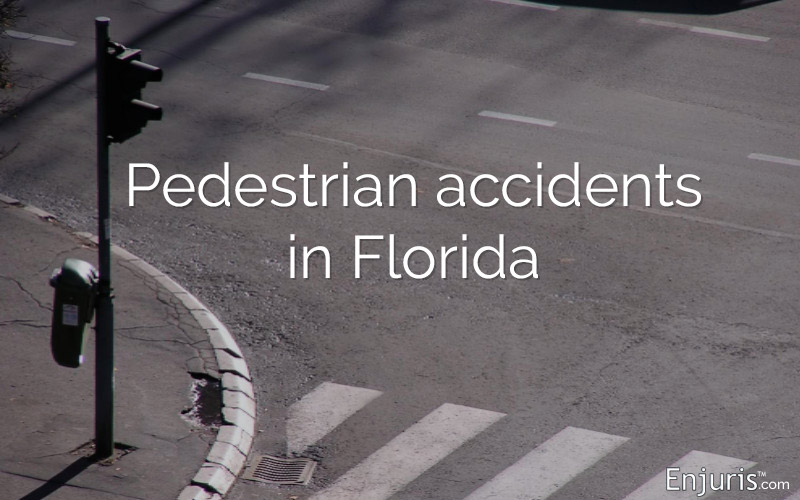
The hazards of crossing the street in Florida
Nobody expects to go for a walk and get hit by a car, but it does happen – quite frequently.
In Florida, pedestrian accidents happen more frequently at night (visibility is always a factor) and in cities more often than in rural areas.
However, in cities, pedestrian accidents do not happen most often in intersections, like one might assume; they tend to happen on sidewalks, in crosswalks, or on the side of the road. These injuries can be overwhelming or fatal.
The driver may be held liable for damages in a negligence case, which could include:
- Medical expenses
- Funeral expenses if the pedestrian passes away
- Lost wages
- Pain and suffering
- Permanent disability or disfigurement
- Loss of consortium
The injured plaintiff would have four years from the date of injury to bring a personal injury case (two years for wrongful death). Let's take a look at Florida pedestrian laws in detail.
Right of way laws for Florida pedestrians
According to the state's pedestrian laws, walkers must obey any official traffic control device unless otherwise directed by a police official. A device would include traffic signs, signals or pavement striping.
Additionally, if a sidewalk is readily available, pedestrians should not use the roadway. If sidewalks are not available or are under construction, however, they should use the shoulder on the left side of the roadway facing traffic.
When crossing the roadway, pedestrians are:
- Subject to traffic signals;
- Not allowed to leave the curb until the traffic signal tells them to;
- Not allowed to yield to right-of-way vehicles;
- To keep to the right half of crosswalks;
- To cross the roadway at a right angle or by the shortest route (except within a marked crosswalk);
- Only allowed to cross a roadway intersection diagonally unless authorized by an official traffic control device; and
- Not allowed to cross between two adjacent intersections, except when they are in a marked crosswalk.
There are more rules, but they are very particular ("no pedestrian may jump or dive from a publicly owned bridge," for instance, and no person shall hitchhike on a public Florida street).
Why pedestrian accidents happen
When new drivers complete Driver's Education classes, they are focusing on the cars – oftentimes, they neglect to think about the pedestrians and the various pedestrian laws that are in place to protect them. The most that Driver's Ed focuses on is "Don't Hit That Person."
This can lead to forgetting about those laws later on when they are driving, or driving in a reckless fashion. Some of the more common reasons for these accidents include:
- Slowdowns because of traffic, bad weather, or crowds
- Yielding to a pedestrian in a crosswalk, but not stopping in time
- Failing to come to a total stop at stop signs
- Drinking and driving
- Failing to maintain vehicle control
Types of pedestrian injuries
Serious injuries can happen when a car hits a pedestrian. Think about it – an enormous piece of steel is hitting a tiny person, and that person is usually not coming fully clothed from playing goalie at soccer practice. In comparison, the fact that anyone can survive is astonishing.
Severe injuries are frequent, because it's not like the victim is wearing protective armor. The forward momentum from the car is then transferred to the walker, which then causes him or her to be thrown several feet or yards. When the pedestrian strikes the ground, head injuries, broken bones and lacerations can occur.
The worst injuries include:
- Brain injuries
- Spinal injuries
- Fractures
- Lacerations
- Paralysis
- Loss of limbs
Fault in Florida
What happens if a pedestrian and a driver are both to blame for an accident? Like, let's say that someone darted into traffic at a place not designated for pedestrians, and there was no walking light to speak of. The driver had no way to stop in time. What do you do then?
Florida follows the pure comparative negligence standard, which means that even if a person is 99% responsible for an accident, he or she can collect that 1% of damages. A jury would look at the situation and apportion fault between the two parties based on the facts of the case.
If you have been in a Florida pedestrian accident, it would be worth your time to speak to a qualified personal injury attorney. Consider looking through the Florida law firm listings to find someone who can help you.
Helpful resources to help you hire the best Florida personal injury lawyer
- Choosing a personal injury attorney – interview questions
- When do you NOT need an attorney after an accident?
- Preparing to meet with a personal injury attorney
- How damages are calculated
- Pedestrian safety
- Everyone is a pedestrian
See our guide Choosing a personal injury attorney.
